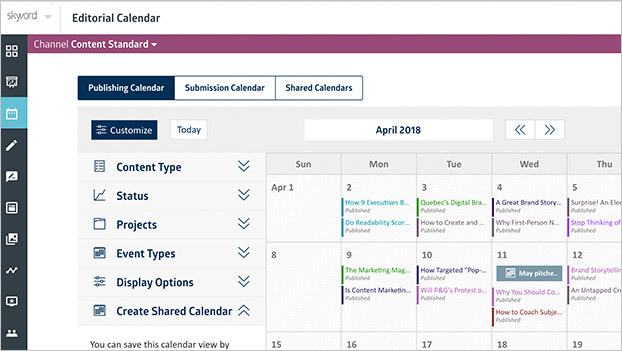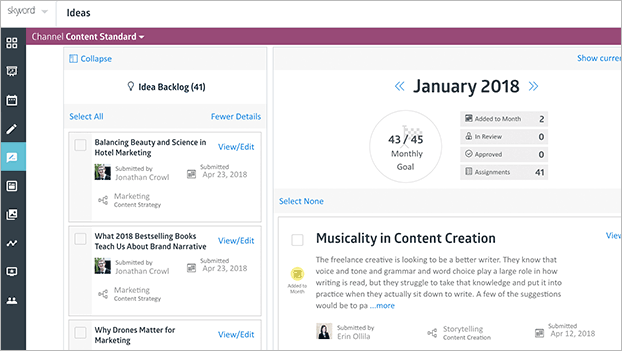Content Creation
Avoid Brainstorm Burnout With a Long-Term Approach to Ideation Management
By Erin Ollila on August 8, 2018
With so many moving pieces to a successful content strategy, coming up with topics can be one of the toughest parts of the process. Ideation management is often the biggest pain-point I hear from marketing teams. More and more marketers are tasked with weekly or monthly brainstorming meetings to ensure you're producing fresh content ideas. However, these meetings often place a lot of pressure on your marketing team to pitch a brilliant content idea about a topic they may not have even been aware of until about five minutes before the meeting began. And while there are certainly instances of successful creative epiphanies, more often than not, trying to come up with a brilliant batch of new ideas on the spot results in a total mental roadblock.
To avoid brainstorming burnout, focus on doing your editorial planning in longer sprints. Consider building out a full monthly or quarterly editorial calendar by coming up with large batches of content ideas in a single period that will still generate interest throughout your publishing cycle.
It's a lofty goal, but achievable with the right ideation techniques and processes in place.
In considering this shift, be aware that the idea of long-form planning can inspires anxiety. While some find comfort in planning out their content an entire year in advance (me included), others feel completely bogged down by such future-forward planning. They want room in their editorial schedules to address industry shifts, upcoming news and trends, or simply just to have the option to change their minds. If you fall into the second category, keep this in mind-your content calendar doesn't have to be set in stone for the entire year ahead. Instead, a long-term strategy simply imposes parameters that keep you aligned with your overall goals. You can make space for some planned future content while still leaving room for whimsy and time-sensitive reporting. The key is to take the stress off of you for constant, routine strategizing and topic creation.
Prevent your marketing teams and creators from running into those frustrating mental blocks by building a broader scale ideation strategy that moves beyond the individual pitch or weekly brainstorming session.
Utilize An Editorial Calendar
Image attribution: Eric Rothermel
Now, this may sound like an obvious solution to ideation management, but hear me out. According to the Content Marketing Institute, 38% of B2B marketers don't even have a documented content strategy. While you may think you're running on an editorial cycle of end-of-month pitching and assigning, you're not be as organized as you could be. A basic editorial calendar should show you-at a glance-what upcoming content you're publishing and when. As you fill out your calendar each month it will also become a useful backlog of anything that you've previously created and is live on your website.
A more advanced editorial calendar will showcase a range of dates and potential content for at least a year in advance. On this, you'll see ideas based around industry trends, holidays, and other date-specific content campaigns that have already been planned out. It will also indicate who on your team is responsible for what content, and where in the various stages of content creation each item is currently. Advanced editorial calendars may also indicate which content is evergreen material and may include notes on social media campaigns belonging to anything previously produced.
Create Categories for Your Content Hub
If you're looking to develop a long-term, strategic content calendar, know the main categories you need to fill. Sometimes, the easiest way to handle ideation management is simply being organized with what it is you need to create in the long-term. Do you have predetermined publishing categories? If not, audit your content, and determine whether natural themes reoccur. Then, decide how often you'll publish each new piece over the course of the year to get a sense of how the total amount of content you'll need to allot into each different category.
For example, this publication-the Content Standard-has three main sections: Creativity, Marketing, and Storytelling. If content publishing goals were to provide even coverage of three main categories, then a color-coded and filterable editorial calendar makes it easier to identify which categories needs most attention, and you can spend time mind mapping on those particular topics during your brainstorms, versus trying to generate ideas for every subject area at once.
Skyword's Editorial Calendar planning tool, featured below, provides an example of an effective way to categorize and schedule out your different kinds of content.

Image attribution: Skyword
Your publishing cadence will depend on what best suits the needs and scope of your content team. No matter if you're publishing multiple times per day or ten pieces of content per month, understanding the total quantity and categorizing it into distinct buckets will give you a much more robust understanding of your workload and the kinds of ideas you should be focusing on.
Reuse & Recycle
Stop trying to reinvent the wheel. Whenever you ideate one idea or topic, make a plan for various ways you can use it. You likely already have more than one content campaign running at a time. Maybe you're producing videos, a podcast, or creating comics for your audience, in addition to blogging and crafting the occasional e-book. Plan ways to get multiple uses out of the same ideas, and then spread the content out over a longer period of time.
For example, let's say you produce original research-the data from your findings can be used to create a large pool of social media posts. Discussion with a podcast guest or video content can be turned into blog posts, with the audio or visuals embedded directly into the article, and white papers can be broken down into different chapters, where each one is a new topic that can be discussed on any of the previously mentioned content forms.
And, let's not forget about the power of resharing your popular previously published content. If you have an article that has been performing well, update it and reshare on your platforms. You can also consider repurposing content into new formats such as using old articles for ideation management on different mediums, such as video or audio.
Image attribution:Neslihan Gunaydin
Keep a Content Pool Filled
When content strategists attempt to fill in content idea gaps as quickly as possible, their first instinct is often to grab onto any trend or recent news story without thinking about how it fits within the context of their organization's individual strategy plan. This is why keeping a content pool filled year round is so important.
Not quite sure what a content pool is? It's actually a rather simple concept. A content pool is a list of potential, pre-aligned topics that can be pulled from at a moment's notice. Content pools should be refilled with new ideas all the time, not just before your monthly editorial session. It doesn't matter how absurd or outlandish these topics may seem at the time, as your strategy develops, you might find a new way to approach these once way-out-of-the-box ideas.
The Content Standard team maintains a backlog of ideas within Skyword360. Their solution for ideation management includes what can be best described as "whiteboarding technology that allows us to systematize and centralize freeform discussion and idea elaboration in one place."

Image attribution: Skyword
But if you have no content pool to begin with, stock your list with any rejected pitches or ideas from your most recent content brainstorming session. Then, throughout the course of the month, add in any idea that comes to your head. These might be unique observations from your own daily work, conversations with coworkers and family members, or interesting insights you find in the news. Let your collection serve as a bank of potentials where you'll withdraw from at a later time.
Allowing Your Creatives to Pitch Ideas
Now, letting freelancers pitch ideas to fill an editorial calendar is nothing new. However, it usually happens on a monthly basis or at-random. Why not create a cycle where you schedule a quarterly brainstorming session with your creative talent in addition to your regular meeting with your marketing team. Let them know what you plan on focusing on over the next three months and then allow them to brainstorm ideas based on those topics.
By involving your creatives in to your strategy, they'll be better prepared to immerse themselves in your brand voice. By cluing them into your goals-even providing them insights into your brand personas-you're better ensuing that the ideas they're generating will be in line with your larger brand mission. Plus, ideating four times a year, instead of once every twelve months, will keep your creators more inspired as well as up-to-date on the current direction of your content strategy, so they aren't pitching topics that are no longer relevant.
Quarterly creative meetings also put the onus on you to analyze both your previous content performance as well as your overall content strategy. You'll need to do some serious prep in order to lead the conversation with analytical updates and future campaign goals. While this might seem like extra work, getting to know your content this well also helps you to better lead a brainstorming session and prevent you from ever again scrambling for ideas to fill in upcoming content gaps further down the road.
Featured image attribution: Tachina Lee



